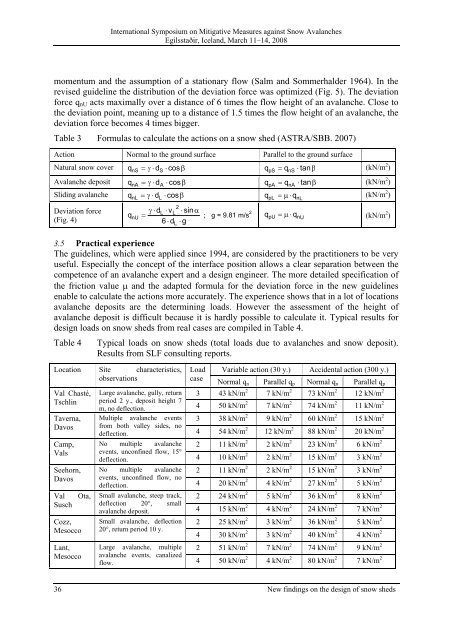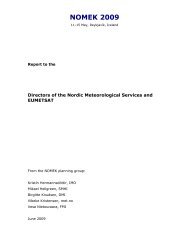International Symposium on Mitigative Measures against Snow ...
International Symposium on Mitigative Measures against Snow ...
International Symposium on Mitigative Measures against Snow ...
You also want an ePaper? Increase the reach of your titles
YUMPU automatically turns print PDFs into web optimized ePapers that Google loves.
<str<strong>on</strong>g>Internati<strong>on</strong>al</str<strong>on</strong>g> <str<strong>on</strong>g>Symposium</str<strong>on</strong>g> <strong>on</strong> <strong>Mitigative</strong> <strong>Measures</strong> <strong>against</strong> <strong>Snow</strong> Avalanches<br />
Egilsstaðir, Iceland, March 11–14, 2008<br />
momentum and the assumpti<strong>on</strong> of a stati<strong>on</strong>ary flow (Salm and Sommerhalder 1964). In the<br />
revised guideline the distributi<strong>on</strong> of the deviati<strong>on</strong> force was optimized (Fig. 5). The deviati<strong>on</strong><br />
force qnU acts maximally over a distance of 6 times the flow height of an avalanche. Close to<br />
the deviati<strong>on</strong> point, meaning up to a distance of 1.5 times the flow height of an avalanche, the<br />
deviati<strong>on</strong> force becomes 4 times bigger.<br />
Table 3 Formulas to calculate the acti<strong>on</strong>s <strong>on</strong> a snow shed (ASTRA/SBB. 2007)<br />
Acti<strong>on</strong> Normal to the ground surface Parallel to the ground surface<br />
Natural snow cover = γ ⋅ d ⋅ cosβ<br />
= q ⋅ tan<br />
Avalanche deposit β<br />
Sliding avalanche β<br />
Deviati<strong>on</strong> force<br />
(Fig. 4) g<br />
qnS S<br />
qpS nS β<br />
(kN/m 2 )<br />
qnA = γ ⋅ dA<br />
⋅ cos<br />
qpA = qnA<br />
⋅ tanβ<br />
(kN/m 2 )<br />
qnL = γ ⋅ dL<br />
⋅ cos<br />
qpL = μ ⋅ qnL<br />
(kN/m 2 )<br />
2<br />
γ ⋅ dL<br />
⋅ vL<br />
⋅ sinα<br />
qnU<br />
= ; g = 9.81 m/s<br />
6 ⋅ dL<br />
⋅<br />
2 qpU = μ ⋅ qnU<br />
(kN/m 2 )<br />
3.5 Practical experience<br />
The guidelines, which were applied since 1994, are c<strong>on</strong>sidered by the practiti<strong>on</strong>ers to be very<br />
useful. Especially the c<strong>on</strong>cept of the interface positi<strong>on</strong> allows a clear separati<strong>on</strong> between the<br />
competence of an avalanche expert and a design engineer. The more detailed specificati<strong>on</strong> of<br />
the fricti<strong>on</strong> value μ and the adapted formula for the deviati<strong>on</strong> force in the new guidelines<br />
enable to calculate the acti<strong>on</strong>s more accurately. The experience shows that in a lot of locati<strong>on</strong>s<br />
avalanche deposits are the determining loads. However the assessment of the height of<br />
avalanche deposit is difficult because it is hardly possible to calculate it. Typical results for<br />
design loads <strong>on</strong> snow sheds from real cases are compiled in Table 4.<br />
Table 4 Typical loads <strong>on</strong> snow sheds (total loads due to avalanches and snow deposit).<br />
Results from SLF c<strong>on</strong>sulting reports.<br />
Locati<strong>on</strong> Site characteristics,<br />
observati<strong>on</strong>s<br />
Val Chasté,<br />
Tschlin<br />
Taverna,<br />
Davos<br />
Camp,<br />
Vals<br />
Seehorn,<br />
Davos<br />
Val Ota,<br />
Susch<br />
Cozz,<br />
Mesocco<br />
Lant,<br />
Mesocco<br />
Large avalanche, gully, return<br />
period 2 y., deposit height 7<br />
Load Variable acti<strong>on</strong> (30 y.) Accidental acti<strong>on</strong> (300 y.)<br />
case<br />
Normal qn Parallel qp Normal qn Parallel qp<br />
3 43 kN/m 2 7 kN/m 2 73 kN/m 2 12 kN/m 2<br />
m, no deflecti<strong>on</strong>. 4 50 kN/m 2 7 kN/m 2 74 kN/m 2 11 kN/m 2<br />
3 38 kN/m 2 9 kN/m 2 60 kN/m 2 15 kN/m 2<br />
Multiple avalanche events<br />
from both valley sides, no<br />
deflecti<strong>on</strong>. 4 54 kN/m 2 12 kN/m 2 88 kN/m 2 20 kN/m 2<br />
2 11 kN/m 2 2 kN/m 2 23 kN/m 2 6 kN/m 2<br />
No multiple avalanche<br />
events, unc<strong>on</strong>fined flow, 15°<br />
deflecti<strong>on</strong>. 4 10 kN/m 2 2 kN/m 2 15 kN/m 2 3 kN/m 2<br />
2 11 kN/m 2 2 kN/m 2 15 kN/m 2 3 kN/m 2<br />
No multiple avalanche<br />
events, unc<strong>on</strong>fined flow, no<br />
deflecti<strong>on</strong>. 4 20 kN/m 2 4 kN/m 2 27 kN/m 2 5 kN/m 2<br />
2 24 kN/m 2 5 kN/m 2 36 kN/m 2 8 kN/m 2<br />
Small avalanche, steep track,<br />
deflecti<strong>on</strong> 20°,<br />
avalanche deposit.<br />
small<br />
4 15 kN/m 2 4 kN/m 2 24 kN/m 2 7 kN/m 2<br />
2 25 kN/m 2 3 kN/m 2 36 kN/m 2 5 kN/m 2<br />
Small avalanche, deflecti<strong>on</strong><br />
20°, return period 10 y.<br />
4 30 kN/m 2 3 kN/m 2 40 kN/m 2 4 kN/m 2<br />
2 51 kN/m 2 7 kN/m 2 74 kN/m 2 9 kN/m 2<br />
Large avalanche, multiple<br />
avalanche events, canalized<br />
flow. 4 50 kN/m 2 4 kN/m 2 80 kN/m 2 7 kN/m 2<br />
36 New findings <strong>on</strong> the design of snow sheds











